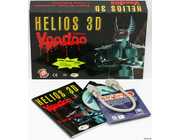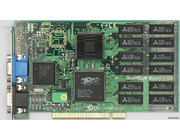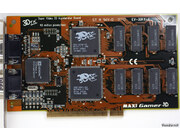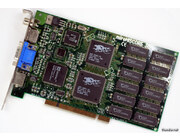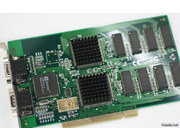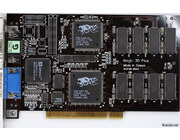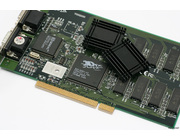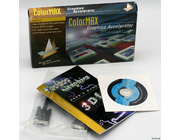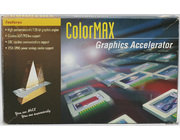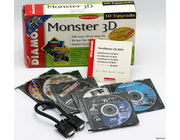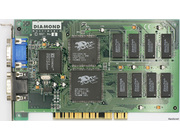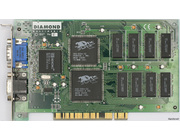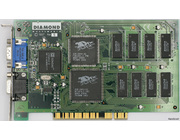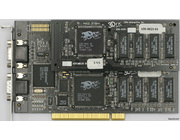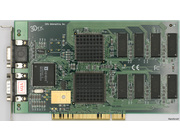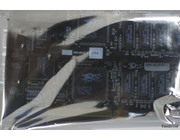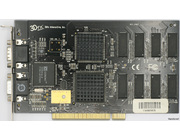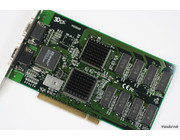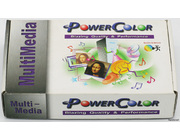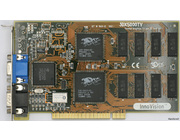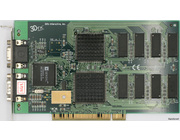SST stands for Ross Smith, Gary Tarolli and Scott Sellers; the founders of 3Dfx.
The Voodoo Graphics chipset consists of two chips. A TMU and FBI chip. The TMU is the Texture Mapping Unit and places the textures onto 'things'. The FBI (Frame Buffer Interface) combines colors, adds fog and is able to do alpha blending, dithering and stuff like that. These two chips together are the actual Voodoo Graphics chipset. Small sidenote: the 3dfx technical specs refer to TREX instead of TMU. Most people refer to TMU because 'TMU' is printed onto the packaging of the chip. TREX stands for Texture Raster Engine.
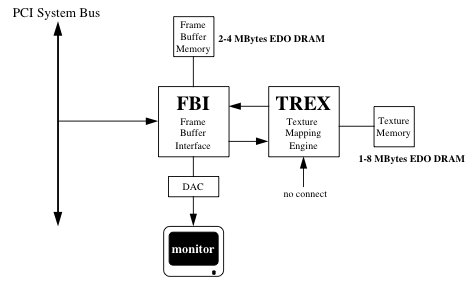
This is a diagram of the Voodoo Graphics. It speaks practically for itself. See how chips are combined and think about having two or even three TMU (TREX) chips! Three TREX chained together provide single-pass, full-speed rendering of all supported advanced texture mapping features. For example: this means you can do trilinear filtering with mipmapping in one pass. A board with 'only' two chips would need two passes and a board with one chip is not capable of doing trilinear filtering with mipmapping.
Voodoo Graphics and Voodoo II cards made by A-Trend are not difficult to find. A lot of third-party vendors used A-Trend cards and 'rebranded' them by sticking them in their own themed box.
This particular A-Trend card is sold by A-Trend themselves. A lot of vendors followed 3Dfx' reference design and so did A-Trend. However, A-Trend added heatsinks that even include thermal paste in the middle. I've not seen this combination of adhesive-tape with thermal paste on other cards before. Not a bad decision to keep the cards cooler and more reliable in bad ventilated cases. > Read more
The MightyFX 6M is a somewhat different Voodoo Graphics card and it differentiates itself by having 6MB of RAM instead of 4MB. It also has a heatsink on the TMU chip which not all manufacturers bothered to add. At last but not least there are empty spots for TV-out connectors and support chips. My card doesn't have these filled and I can't remember seeing a MightyFX-branded card that did have TV-out functions.
Interesting to note is that InnoVISION also sold the Cyber3D X5000 (3DX5000) branded cards. The Cyber3D X5000 is available in 4MB and 6MB versions as well and usually comes with a brown PCB. Some versions of the Cyber3D X5000 have memory chips that are mounted vertical whereas others have horizontal mounted chips. All MightyFX cards I've seen had horizontal chips.
The link to the similar benchmarks points to the miroMEDIA miroHISCORE 3D 6MB card. Despite that the miroHISCORE card is different in connectors and lay-out it doesn't really perform different than the MightyFX 6M so benchmarks are comparable. Back in the day when these cards were new you would sometimes see performance differences between brands which was usually the cause of different drivers (I use the latest generic 3dfx drivers) and slight overclocks. > Read more
This is just a normal good working Voodoo Graphics board. The PCB slightly differs from 3Dfx' reference layout but nothing big there. The biggest difference can be found in the color of the PCB. Not much Voodoo cards are brown like this. > Read more
A well equipped Voodoo Graphics card! This one has more then enough RAM and also features a TV-Out connector. Though the extra 2MB (4MB total) texture memory is not very useful since many games are programmed to use just 2MB of memory. After all, the regular boards only have 4MB of RAM in total and thus 2MB texture memory. As seen in the benchmarks: Unreal is the only real-life benchmark that shows a slight increase.
Also don't think this board will be able to run 800x600 because of the extra RAM. The board only has 2MB frame buffer which is not enough for 800x600 or higher resolutions. Of course 800x600 is possible by using single frame buffers or disabling Z-buffers.
As seen on the photo's this Voodoo card does not use the regular VGA pass-through cable. Instead, only one D-SUB connector and one 9-pin round VGA connector is installed. This was necessary in order to fit the TV-Out connectors. In case you want to buy a miroHIGHSCORE 3D board, make sure the correct pass-through cable is included!
The miroHISCORE 3D was announced on August 27 of 1997. > Read more
A more then regular Voodoo Graphics board as the card itself was made by A-Trend; not Colormaster. Lot's of companies, including Colormaster, just sold an A-Trend board using their own name. A-Trend uses the 3Dfx reference design of the SST-1. You can recognize A-Trend boards because of the AQA sticker and the dot-sticker (in this case yellow) on the back of the PCB. The PCB also carries the number 3920465A1. A-Trend boards sometimes carry -465 as well.
Personally I think the box is interesting. The picture shows something that exactly matches the name 'Voodoomania' and on the backside a screenshot of the Egypt-style 3Dfx techdemo's is included. As far as I know the Voodoomania 3D is one of the few Voodoo Graphic boards that is shipped with diskettes instead of a driver CD with utilities, demos and stuff. > Read more
A Voodoo Graphics (SST-1) chipset loaded with a whopping 8MB of RAM. Normally the Voodoo Graphics would only have 4MB RAM. Some models are shipped with 6MB and 8MB RAM but these are harder to find.
This card has been made somewhere mid 1998 which makes it a relative new Voodoo Graphics board. Consider the fact that the chipset was already available somewhere in 1996! In mid-1998 the Voodoo 2 was widely available.
The PCB also has an interesting differentiation: it shows empty traces for SLI chip/connectors and Amethyst Daughter board to add an extra TMU and 4MB of RAM. The latter can be found on the Quantum3D Obsidian SB50-4220 for example.
In case you want the ultimate Voodoo Graphics solution and in case you have enough money, this is what you should do: Get two of these boards. Get two SB50-4220 to rip off the Amethyst board and find the correct parts for the SLI connector. Also find a flatcable which is suitable. Fix everything together and enjoy your 12MB, dual-TMU SST-1 boards in SLI! Of course I can't guarantee this will work... ![]() . > Read more
. > Read more
Just like the other VP-503's so see those entries for more information. > Read more
Just like my other Colormax VP 503. This card was sold by Colormax but made by A-Trend. > Read more
A regular 'cheap' and bone-stock Voodoo Graphics card. Made by Powercolor to compete with the big guys that did ship games or made their own drivers. I accidentally killed this card by removing the heatsinks because one of the chips came loose. If you ever try to remove a heatsink from a Voodoo Graphics or Voodoo II; be very careful because the pins of the PQFP-chips are quite weak. > Read more
And yes, another Monster 3D! This time it's a Europe retail model which includes a box and game CD's ![]() . This was 'the' 3D upgrade back then. I guess a lot of people didn't install a 3Dfx card. No, they installed a Monster3D card instead, not realizing it was a 3Dfx card after all.
. This was 'the' 3D upgrade back then. I guess a lot of people didn't install a 3Dfx card. No, they installed a Monster3D card instead, not realizing it was a 3Dfx card after all.
The Voodoo Graphics chipset consists of two chips. A TMU and FBI chip. The TMU is the Texture Mapping Unit and places the textures onto 'things'. The FBI (Frame Buffer Interface) combines colors, adds fog and is able to do alpha blending, dithering and stuff like that. These two chips together are the actual Voodoo Graphics chipset. Small sidenote: the 3dfx technical specs refer to TREX instead of TMU. Most people refer to TMU because 'TMU' is printed onto the packaging of the chip. TREX stands for Texture Raster Engine.

This is a diagram of the Voodoo Graphics. It speaks practically for itself. See how chips are combined and think about having two or even three TMU (TREX) chips! Three TREX chained together provide single-pass, full-speed rendering of all supported advanced texture mapping features. For example: this means you can do trilinear filtering with mipmapping in one pass. A board with 'only' two chips would need two passes and a board with one chip is not capable of doing trilinear filtering with mipmapping. > Read more
Another one in million Diamond Monster 3D Voodoo card. What can I say about it? Check out the other Diamond Monster 3D entries or follow this link to read about my boxed version of the Monster 3D and to read how the the 3Dfx chips work together ![]() . > Read more
. > Read more
Another Diamond Monster 3D! It's a Voodoo Graphics and will fit nicely in a high-end Pentium MMX or early Pentium II. There are no unique things specific to this card. It has the standard recipe: SST-1 chipset (1xTMU/1xFBI with each 2MB).
You can read more about the more and see photo's of the retail box here. > Read more
And another Monster 3D. This time it's an E-revision. Maybe I have too much of these boards, or maybe not. Practically every board is a bit of unique, however. This one has GLT44017-40J4 RAM which was unknown to me. GLT stands for 'Galvantech Inc.' > Read more
A gift from someone.
A revision G of the famous Diamond Monster 3D boards. It has a 500-0004-02 TMU and 500-0003-03 FBI. The TMU is the Texture Mapping Unit and places the textures onto 'things'. The FBI (Frame Buffer Interface) combines colors, adds fog and is able to do alpha blending, dithering and stuff like that. These two chips together are the actual Voodoo Graphics chipset. > Read more
I acquired two Quantum3D Obsidian SB50-4220 cards (both came in unopened ESD-bag) so I could leave one factory-sealed and use this card for benchmarking and to fiddle around with.
The Obsidian 50-4220 has two TMU chips (Texture Management Unit) and one FBI chip (Frame Buffer Interface). 4MB for the FBI and 2MB per TMU. The second TMU is mounted on the extension board which is called 'Amethyst'. Regular Voodoo Graphics (Voodoo 1) are usually equipped with one TMU and FBI with 2MB per chip.
Other configurations of the Obsidian exist as well. You can tell by the model number which configuration it has. I.e. a 50-2200 has a 2MB FBI and 2MB TMU. A 50-2220 has a 2MB FBI, a 2MB TMU and a second 2MB TMU.
Due to the extra RAM the Obsidian 50-4220 is able to run at a 800x600 resolution. In most cases the 800x600 resolution is not ideal because most 'recent' games (1997, 1998-ish. This card is from 1996!) are too demanding.
Games like Quake 3 and Unreal are able to make use of the extra TMU chip. The benchmarks show a clear improvement over the regular Voodoo Graphics card: Unreal even scores 53% faster compared to a regular 4MB Diamond Monster 3D.
All in all this card is performing very well. It's the oldest Voodoo Graphics based card I have (regular Voodoo's usually are made in 1997 or even 1998) and also the fastest Voodoo Graphics card I have. If you ever decide to go back to 1996 and think that just one card was not enough ... these cards were also available with SLI option! An option often dubbed as Voodoo2-only but truth is that the first Voodoo chips already had the SLI feature available. It's just that manufacturers didn't implement the right connectors and support chips on their boards. Back in the day it would've been far too expensive and not suitable for gaming since CPU's weren't fast enough. > Read more
Bought at once with my first Voodoo card: Helios 3D Voodoo at the same fair. If I recall correctly my brother bought two cards and a buddy of him one, leaving us with four brand-new Voodoo's! > Read more
I have two of these cards. This one is still sealed in it's Original ESD-bag; but I openend the other one for testing. For more information please read the text written at the page for the other card. > Read more
A-Trend was big manufacturer of 3Dfx cards at the time. I don't have numbers on this statement but many suppliers sold rebranded A-Trend cards in a different box as well. Looking at 3Dfx-collections and what is available in the second-hand market I often see A-Trend cards. You can spot them on the ATC-2465 marking on the sticker with a yellow, red (or perhaps blue) dot on them. This particular card has a red dot.
I have three yellow dotted A-Trend Helios 3D Voodoo cards that came in an official A-Trend box. I'm unsure if the red dotted card came in an official A-Trend box as well.
The A-Trend cards are of high quality. They have heatsinks and in most cases they are also fitted with thermal interface material for better heat transfer. > Read more
A Powercolor Voodoo card in box. The box has been opened but the ESD shielding is still closed.
This is a good example of a company selling a cheap Voodoo card (and trying to compete with the big names like Diamond and Creative). The box design is quite basic and this design has been used for all sorts of graphics cards. > Read more
A late Voodoo Graphics with a slightly different layout because of the spots for the TV-out. It also has a Texas Instruments RAMDAC for display output whereas most cards have an ICS GENDAC chip. > Read more
This is my first 3Dfx card I bought (and still have). The card has been purchased on a fair named 'HCC Dagen' and did it's job for quite a while in my systems. At the time I bought it the card was brand new but the technology was aging. If I recall correctly it was 2001 when I bought this card for my Intel Pentium II.
Later on I sold the Pentium II as it didn't run as it should be (Deschutes 350MHz on a 440LX chipset running at 83FSB / 291MHz). My trusty Intel Pentium 133 @ 166 (83MHz FSB, 430TX chipset) was back in action along with this 3Dfx card. Tweaking everything on the PC made it flew like madness. Some of the SET variables I used to tweak the 3Dfx card are: SET SST_SCREENREFRESH=75, SET SST_GRXCLK=57, SET SST_FASTMEM=1, SET SST_FASTPCIRD=1, SET SST_VIDEO_24BPP=1, SET FX_GLIDE_NO_SPLASH=1, SET FX_GLIDE_SWAPINTERVAL=0. Also setting the GAMMA correction lower (default is 1.3) resulted in an increase of the image quality.
As seen on the pictures this board has a yellow dot (sticker) on the back. Along with the AQA sticker on one of the D-SUB's this is a characteristic of A-Trend. Some Voodoo Graphics cards have a red dot. The blue dot can only be found on the Voodoo Rush. A-Trend produced a lot of boards which other companies rebranded. This Helios 3D card was sold using the name 'A-Trend Helios 3D'. Other cards were sold with a total different name but the comming A-Trend markings reveal their true identity. > Read more
